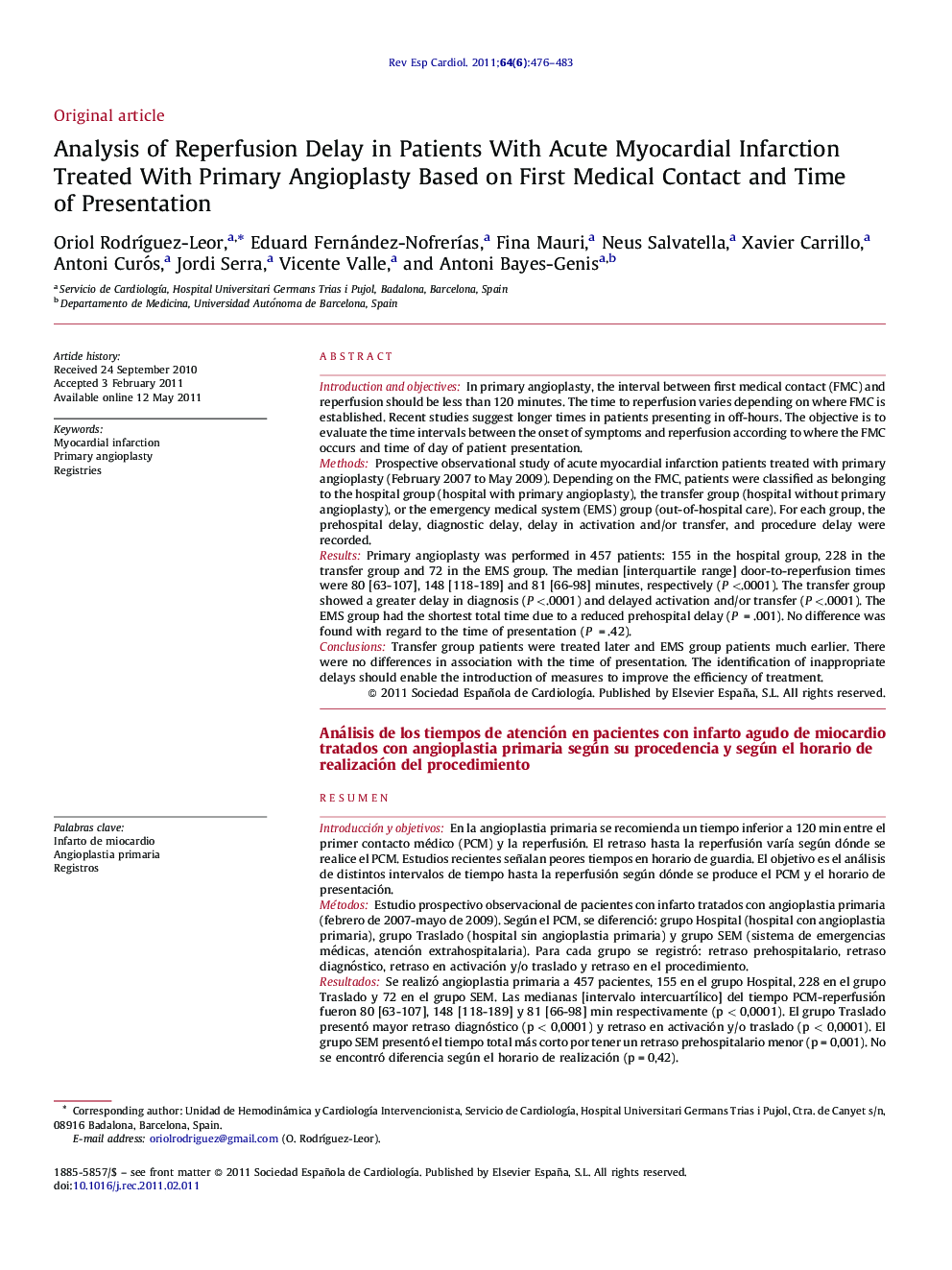| Article ID | Journal | Published Year | Pages | File Type |
|---|---|---|---|---|
| 3016879 | Revista Española de Cardiología (English Edition) | 2011 | 8 Pages |
Introduction and objectivesIn primary angioplasty, the interval between first medical contact (FMC) and reperfusion should be less than 120 minutes. The time to reperfusion varies depending on where FMC is established. Recent studies suggest longer times in patients presenting in off-hours. The objective is to evaluate the time intervals between the onset of symptoms and reperfusion according to where the FMC occurs and time of day of patient presentation.MethodsProspective observational study of acute myocardial infarction patients treated with primary angioplasty (February 2007 to May 2009). Depending on the FMC, patients were classified as belonging to the hospital group (hospital with primary angioplasty), the transfer group (hospital without primary angioplasty), or the emergency medical system (EMS) group (out-of-hospital care). For each group, the prehospital delay, diagnostic delay, delay in activation and/or transfer, and procedure delay were recorded.ResultsPrimary angioplasty was performed in 457 patients: 155 in the hospital group, 228 in the transfer group and 72 in the EMS group. The median [interquartile range] door-to-reperfusion times were 80 [63-107], 148 [118-189] and 81 [66-98] minutes, respectively (P <.0001). The transfer group showed a greater delay in diagnosis (P <.0001) and delayed activation and/or transfer (P <.0001). The EMS group had the shortest total time due to a reduced prehospital delay (P = .001). No difference was found with regard to the time of presentation (P = .42).ConclusionsTransfer group patients were treated later and EMS group patients much earlier. There were no differences in association with the time of presentation. The identification of inappropriate delays should enable the introduction of measures to improve the efficiency of treatment.
ResumenIntroducción y objetivosEn la angioplastia primaria se recomienda un tiempo inferior a 120 min entre el primer contacto médico (PCM) y la reperfusión. El retraso hasta la reperfusión varía según dónde se realice el PCM. Estudios recientes señalan peores tiempos en horario de guardia. El objetivo es el análisis de distintos intervalos de tiempo hasta la reperfusión según dónde se produce el PCM y el horario de presentación.MétodosEstudio prospectivo observacional de pacientes con infarto tratados con angioplastia primaria (febrero de 2007-mayo de 2009). Según el PCM, se diferenció: grupo Hospital (hospital con angioplastia primaria), grupo Traslado (hospital sin angioplastia primaria) y grupo SEM (sistema de emergencias médicas, atención extrahospitalaria). Para cada grupo se registró: retraso prehospitalario, retraso diagnóstico, retraso en activación y/o traslado y retraso en el procedimiento.ResultadosSe realizó angioplastia primaria a 457 pacientes, 155 en el grupo Hospital, 228 en el grupo Traslado y 72 en el grupo SEM. Las medianas [intervalo intercuartílico] del tiempo PCM-reperfusión fueron 80 [63-107], 148 [118-189] y 81 [66-98] min respectivamente (p < 0,0001). El grupo Traslado presentó mayor retraso diagnóstico (p < 0,0001) y retraso en activación y/o traslado (p < 0,0001). El grupo SEM presentó el tiempo total más corto por tener un retraso prehospitalario menor (p = 0,001). No se encontró diferencia según el horario de realización (p = 0,42).ConclusionesA los pacientes del grupo Traslado se los reperfundió más tardíamente y a los del grupo SEM, más precozmente. No hubo diferencias según el horario. La identificación de demoras injustificadas debe permitir adoptar medidas que mejoren la eficiencia del tratamiento.
